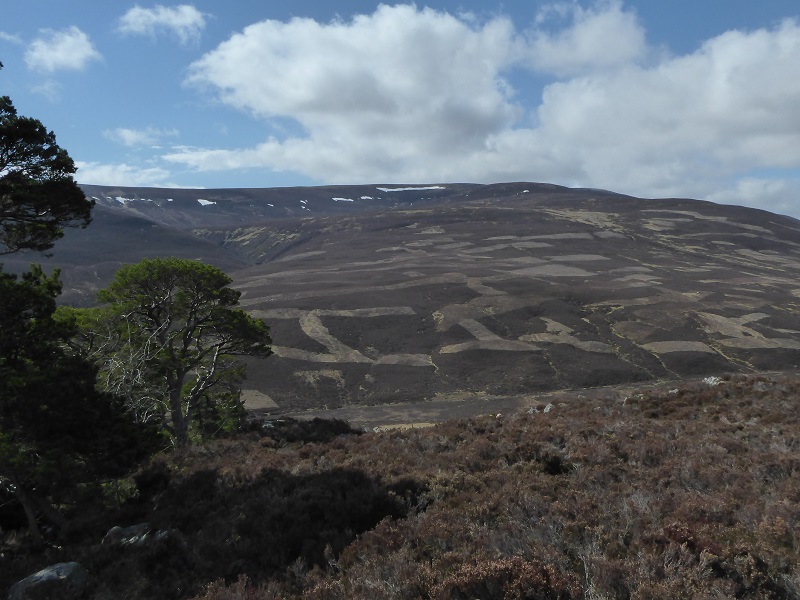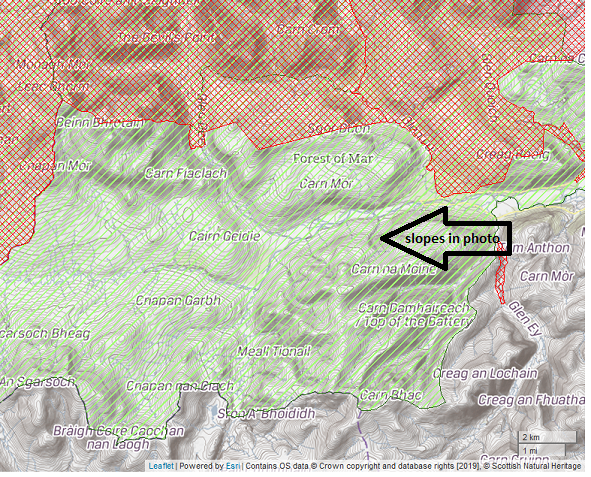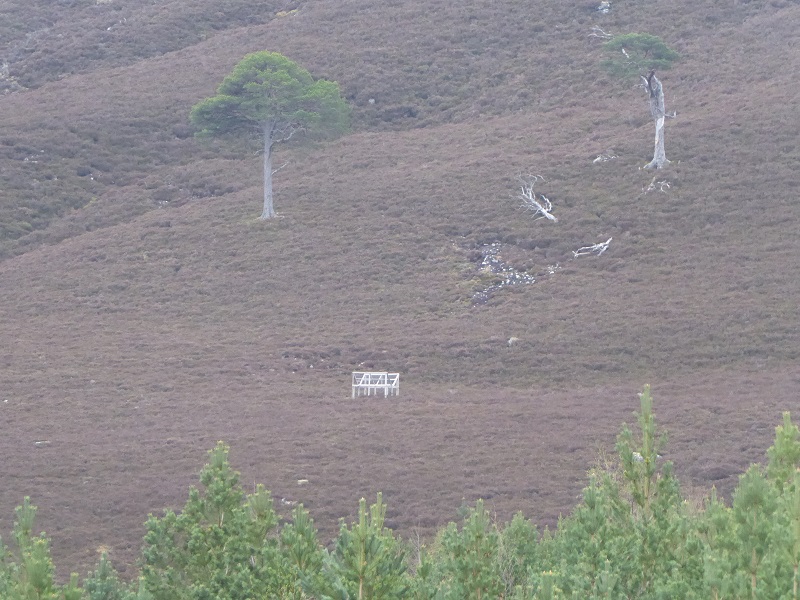
This being the muirburn season – I spotted four examples in the Cairngorms National Park on my way up to Aviemore 12 days ago – it was very interesting to see how the Scottish media picked up on the fire damage caused by a dropped cigarette rather than all the fires deliberately started by landowners. I guess that’s not news, although in England the damaging effects of muirburn has been getting some attention (see here) and the Revive coalition fringe meeting at the Labour Party conference this weekend did raise the issue.
SNH’s short report on the Rum fire (see here) is thorough and measured. Its very positive staff talked to the person who accidentally caused the fire – a student gamekeeper apparently – to understand better what had happened and how it spread. The report explains the varying impacts on different types of vegetation and looks at how the vegetation communities may change as a consequence: for example, if more deer are attracted into the area by new growth resulting from the fire this could increase grazing pressure and ultimately mean that purple moor grass, which is far less palatable to deer, becomes more dominant. The overall conclusion, however, is quite clear. Fires in National Nature Reserves do damage.
It prompts the question, what is SNH doing about fires in other National Nature Reserves and, more specificall,y did they reach agreement with the National Trust for Scotland that muirburn should cease at Mar Lodge BEFORE the whole estate was declared a National Nature Reserve at the end of 2017?

The answer to that question is NOT clear from the SNH Board Paper in May 2017 which approved the creation of the new National Nature Reserve (see here). The only conservation issue at Mar Lodge that paper reported to the Board was Red Deer numbers:
For Mar Lodge Estate, the Partnership [SNH’s advisory body on NNRs] considered whether or not NTS was unduly constrained in its ability to achieve sustainable deer numbers. NTS has given assurances that it is committed to conserving the valuable ecological and landscape features in harmony with its maintenance as a highland sporting estate, and is committed to controlling deer without restriction on open public access. The Partnership was satisfied that, whilst NTS faced significant and ongoing challenges in deer management, it had the necessary commitment and resources to succeed.
Nothing about how the moorland on the estate was being managed.
Unfortunately while SNH publishes the plans for all the nature reserves it manages (see here – look for the “About the Reserve” link), the management plans for nature reserves run by other organisations are not always publicly available. NTS’s web pages on the Mar Lodge NNR (see here) contains information for visitors about how to enjoy the area but there is no information about any new plans consequent on the estate being designated a National Nature Reserve. That’s an information gap which needs to be fixed.
NTS’s Forest Plan (see here), which is public, had previously split Mar Lodge estate into two zones, a regeneration zone – which was protected by nature conservation designations – and a moorland zone which was not. The area along the River Dee south of Carn Mor forms the core of this moorland zone. This was also the area where the NTS had agreed “sporting use” should continue. NTS even erected a fence (see here) along the top of Sgorr Mor to demarcate what was in effect the conservation zone from the “sporting” zone. What the creation of the Mar Lodge NNR has done, however, is to turn the WHOLE estate into a nature reserve.

While SNH now likes to refer to NNRs as an “accolade”, its primary legal purpose is still defined by the 1949 National Parks and Countryside Act. The word “reserve” is important. Its land managed for conservation purposes, where nature comes first, although, unlike in some other countries these are reserves where people can enjoy nature, rather than being excluded from it:
Meaning of “nature reserve.”
(1) In this Part, “ nature reserve ” means—
(a) land managed solely for a conservation purpose, or
(b) land managed not only for a conservation purpose but also for a recreational purpose, if the management of the land for the recreational purpose does not compromise its management for the conservation purpose.
(2) Land is managed for a conservation purpose if it is managed for the purpose of—
(a) providing, under suitable conditions and control, special opportunities for the study of, and research into, matters relating to the fauna and flora of Great Britain and the physical conditions in which they live, and for the study of geological and physiographical features of special interest in the area, or
(b) preserving flora, fauna or geological or physiographical features of special interest in the area,
or for both those purposes.
[F2(2A)In subsection (2)(b) the reference to preserving flora or fauna includes enabling or facilitating its recovery or increase.]
(3) Land is managed for a recreational purpose if it is managed for the purpose of providing opportunities for the enjoyment of nature or for open-air recreation.]
Whether the “sporting use” which has been carried out under NTS’s aegis on the moorland part of the Mar Lodge estate is legally compatible with its new NNR status is a moot point. While it appears that SNH and its advisory body have decided it is, that is not beyond legal challenge. Perhaps this is something that might interest Wild Justice, the new organisation created by Chris Packham and others to take legal action on behalf of wildlife? (see here).
Leaving that legal point aside, however, there are different forms of management for hunting or “sport” which have very different impacts on the natural environment. There is a world of difference between intensive grouse moor management which is focussed on producing large numbers for driven grouse shooting and walked up grouse shooting. The first is akin to farming (preparing the ground (muirburn), controlling disease (medicated grit, hare culls) followed by a clay pigeon shoot. Its difficult to see how any of that is compatible with Mar Lodge being declared a National Nature Reserve. The second, whether you agree with hunting or not, has minimum impacts and is far more akin to other forms of outdoor recreation which take place in our hills.

Now I am not trying to claim that all elements of intensive grouse moor management were being practiced on the sporting part of the Mar Lodge Estate which is now part of the NNR, but extensive muirburn clearly was. In addition there has been some trapping:

In my view neither are compatible with NNR status and SNH’s report on the Rum fire simply reinforces this in respect of fires. So what have NTS and SNH been doing to change how this part of the estate is managed?
We know that in some places in the Cairngorms National Park conservation designations which protect dry and wet heath have been used as a reason to allow damaging practices like muirburn to continue. Muirburn is one way to prevent prevents encroachment by woodland. This has played into the hands of grouse moor owners when, as the newly published Cairngorms Forest Strategy states, of “highly significant” species found in the National Park and which are dependent on one type of habitat “100 are dependent on woodland whilst, by comparison, wetland hosts 12, grassland 8 and moorland only one”. There is NO reason therefore for muirburn, which releases carbon and promotes water run-off and flooding to continue in the moorland part of Mar Lodge Estate.
The challenge for NTS, who are bound by the gift from the Easter Trust to allow sporting use on the estate to continue, is how to create a new model of hunting that might be compatible with NNR status. That means the estate abandoning any management activity whose purpose is to increase grouse numbers by human intervention (muirburn and trapping of corvids). It also means reducing deer numbers, as alluded to in the SNH Board Report, so they no longer spill round the fence into NTS’ forest regeneration zone or over into the Feshie water catchment where they damage the naturally regenerating woodland there.
While this is what needs to happen, I suspect the lack of any new announcement or plans for how the new NNR is managed, suggests that internal “debates” are taking place within NTS about the consequences of NNR designation. On the one side landowners – who have always had a powerful influence over what the organisation does and wish to protect grouse moor interests – on the other, conservationists. SNH should be helping to flush any such debate into the open and driving change in how the NNR is managed. That would then in turn help drive change within the east Cairngorms Moorland Partnership, which is made up of six estates including Balmoral and Mar Lodge. The Cairngorms National Park wants to use this Partnership to demonstrate a different way of managing moorland which is compatible with the objectives of the National Park. What better way to show this is working than a radical change in the way the “sporting” part of Mar Lodge is being managed?

Wood I be correct in saying muirburn is carbon neutral and that not burning it would make it carbon negative? That in fact the sporting estates are not only massacring all the animals but they are happy to kill everything else on the planet at the same time .
The significance of the impact in terms of carbon release depends to an extent on when the burning takes place – if the peat soils below are not damp and burn then significant amounts of carbon may be released. If its just the surface vegetation less so but the repeating burning of course prevents tree regeneration which would take significant carbon out the atmosphere – indeed that is one of main arguments in Scottish Forestry Strategy for why we need to grow more trees
muirburn is toxic, certain plant matter burnt at lower combustion temps causes large soot particles which are a known carcinogen never mind the global warming nonsense what about our children breathing in these fumes up the hills when they are meant to be getting fit diesel fumes all week muirburn for the weekend, we would be as well throwing them from the incubators in the hospitals (true story).
Yes, I have been told muirburn smoke was hanging over the Drumochter a week or so ago so was adding to the diesel!